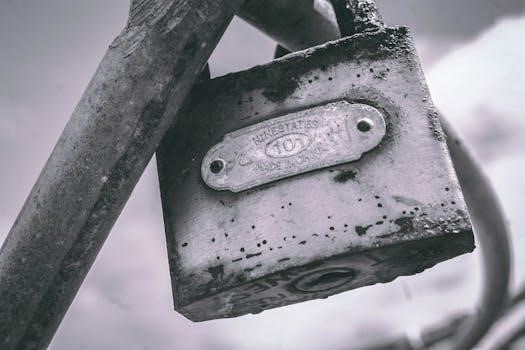Timing Chain and Guides⁚ A Comprehensive Guide
Welcome to our comprehensive guide on timing chains and guides! This essential engine component ensures synchronized operation. We will explore the function, common failure symptoms, causes and maintenance tips. Understanding these aspects is crucial for engine health and longevity for your vehicle.
The timing chain, a critical component within your engine, plays a vital role in synchronizing the crankshaft and camshaft. Its precise operation ensures proper valve timing, impacting overall engine performance. Timing chains have replaced rubber timing belts because they are more sophisticated and durable. Understanding the timing chain’s function, potential issues, and maintenance is crucial for preventing costly engine repairs.
This guide provides an in-depth look at timing chains and guides. We’ll discuss their operation, common symptoms of failure, and the importance of components like the tensioner. Recognizing the early warning signs of a failing timing chain can save you from extensive engine damage. Whether you’re a seasoned mechanic or a vehicle owner, this guide offers valuable insights into maintaining your timing chain and ensuring optimal engine performance.
The timing chain endures constant movement and stress within the engine. Over time, wear and tear can lead to stretching or damage. Regular maintenance and timely replacement are essential for preserving your engine’s health. Let’s delve into the world of timing chains and guides and learn how to keep your engine running smoothly.

Function of the Timing Chain and Guides
The timing chain serves as the crucial link between the crankshaft and the camshaft(s) in an internal combustion engine. This synchronization is paramount for proper engine operation. The crankshaft powers the pistons, while the camshaft controls the opening and closing of the engine’s valves. The timing chain ensures these components work in harmony.
The timing chain’s precise movement dictates when the intake valves open to allow air and fuel into the cylinders and when the exhaust valves open to release combustion gases. Correct valve timing is essential for efficient combustion, optimal power output, and reduced emissions. If the timing chain stretches or malfunctions, the engine’s timing can be thrown off, leading to reduced performance and potential damage.
Timing chain guides play a vital role in maintaining the chain’s correct path and tension. These guides, often made of durable plastic, prevent the chain from vibrating excessively or jumping off its designated path. The guides ensure smooth and reliable operation, preventing premature wear and tear on the timing chain. Proper maintenance and timely replacement of worn guides are essential for preserving the timing chain’s integrity and overall engine health.
Common Symptoms of Timing Chain Failure
Recognizing the symptoms of a failing timing chain is crucial for preventing severe engine damage. One common sign is engine misfires, which occur when the timing is off, disrupting the combustion process. You might also experience rough running, especially at idle, as the engine struggles to maintain a steady rhythm. Unusual rattling noises emanating from the engine, particularly during startup or idling, can indicate a worn or loose timing chain.

Another telltale sign is the presence of metal shavings in the engine oil. These shavings result from the timing chain wearing against other metal components, indicating significant wear. Reduced engine performance and fuel efficiency are also common, as the engine’s timing is no longer optimized for power and economy. The check engine light may illuminate, signaling a timing-related issue that the engine’s computer has detected.
Ignoring these symptoms can lead to catastrophic engine failure. A stretched or broken timing chain can cause the valves to collide with the pistons, resulting in extensive damage. Regular inspections and prompt attention to any of these symptoms are essential for maintaining your engine’s health and avoiding costly repairs.
Engine Misfires and Rough Running
Engine misfires and rough running are prominent indicators of potential timing chain issues. When the timing chain stretches or becomes worn, the precise synchronization between the crankshaft and camshaft is disrupted; This disruption leads to incorrect valve timing, causing one or more cylinders to misfire. Misfires result in incomplete combustion, leading to a noticeable decrease in engine power and efficiency.
Rough running often accompanies misfires, characterized by vibrations and uneven engine operation. The engine may struggle to maintain a smooth idle, exhibiting jerking or stalling. These symptoms are exacerbated under load, such as during acceleration or when climbing hills. The severity of the misfires and rough running can vary depending on the extent of the timing chain wear.
In some cases, the engine may only exhibit these symptoms intermittently, particularly when cold. However, as the timing chain continues to deteriorate, the misfires and rough running will become more persistent and severe; Prompt diagnosis and repair are essential to prevent further engine damage and ensure optimal performance. Ignoring these symptoms can lead to catalytic converter damage and increased emissions.
Rattling Noises from the Engine
One of the most telltale signs of a failing timing chain is a distinct rattling noise emanating from the engine. This rattling sound is often most noticeable during a cold start when the oil pressure is still building. As the timing chain wears and stretches, it loses its proper tension, causing it to slap against the timing chain cover or other engine components. This slapping action creates the characteristic rattling sound.
The rattling noise may also be present at idle or during acceleration, depending on the severity of the timing chain wear. In some cases, the rattling sound may subside as the engine warms up and the oil pressure stabilizes. However, it’s crucial not to dismiss this noise, as it indicates a significant problem that needs immediate attention.
The rattling is often caused by a worn tensioner, failing guides, or a stretched timing chain. Identifying the exact source requires careful inspection. Ignoring the rattling can lead to catastrophic engine failure if the chain jumps teeth or breaks. A professional mechanic should assess the noise and perform necessary repairs to prevent extensive damage. Regular inspections can help prevent such situations.
Metal Shavings in the Oil
The presence of metal shavings in the engine oil is a serious indicator of internal engine wear, often suggesting a failing timing chain or its related components. As the timing chain, guides, and tensioner wear down, they begin to shed tiny metallic particles into the oil. These metal shavings can be detected during an oil change or through an oil analysis.
The shavings are typically small and glittery, resembling fine glitter mixed in with the oil. Their presence signals that metal-on-metal contact is occurring within the engine, which is abnormal. A visual inspection of the drained oil, as well as the oil filter, can reveal the presence of these particles.

The severity of the metal shavings can indicate the extent of the wear. A small amount might suggest early stages of wear, while a larger quantity signifies a more advanced problem. It’s critical to address this issue promptly, as circulating metal shavings can cause further damage to other engine components, such as bearings, cylinder walls, and oil pump.
If metal shavings are found, a thorough inspection of the timing chain components is necessary to determine the source of the wear and prevent catastrophic engine failure. Regular oil changes and oil analysis can help detect this problem early.
Reduced Engine Performance and Fuel Efficiency
A worn or stretched timing chain can significantly impact engine performance and fuel efficiency. The timing chain’s primary function is to synchronize the crankshaft and camshaft, ensuring precise valve timing. When the chain stretches, it throws off this synchronization, leading to a decrease in engine power and responsiveness.
As the timing becomes inaccurate, the engine’s valves may open or close at the wrong time, affecting the combustion process. This can result in reduced power output, especially at lower engine speeds, making the vehicle feel sluggish during acceleration. Drivers might notice a hesitation or lack of power when attempting to merge onto a highway or climb a hill.
Furthermore, the compromised valve timing can negatively affect fuel efficiency. The engine has to work harder to maintain the desired performance level, leading to increased fuel consumption. Drivers may observe a noticeable drop in their miles per gallon (MPG), requiring more frequent trips to the gas station.
In addition to performance issues, a stretched timing chain can cause rough idling and engine misfires. Addressing the problem promptly by replacing the timing chain and related components is crucial to restore optimal engine performance and fuel efficiency. Regular maintenance and timely repairs can prevent these issues.
Check Engine Light Illumination
One of the most common indicators of a timing chain issue is the illumination of the Check Engine Light (CEL) on your vehicle’s dashboard. The CEL is a warning signal that alerts the driver to potential problems within the engine or emissions system. When the engine control unit (ECU) detects irregularities in the timing chain’s operation, it triggers the CEL.
Specifically, a stretched or worn timing chain can cause deviations in the camshaft and crankshaft correlation, leading to diagnostic trouble codes (DTCs) related to timing over-advanced or timing over-retarded conditions. These codes prompt the ECU to activate the CEL, signaling the need for further inspection.
It’s important to note that the CEL can be triggered by various other issues, so a proper diagnosis is essential to pinpoint the exact cause. A mechanic will use a scan tool to retrieve the stored DTCs and analyze the engine’s performance data. Common codes associated with timing chain problems include P0016, P0017, P0018, and P0019, which indicate camshaft position sensor correlation issues.
Ignoring the CEL can lead to more severe engine damage, so it’s crucial to address the problem promptly. If you notice the CEL illuminated, schedule a diagnostic appointment with a qualified mechanic to determine the underlying issue and prevent further complications.
Causes of Timing Chain and Guide Failure
Several factors contribute to the failure of timing chains and their associated guides. Understanding these causes can help in preventative maintenance and early detection of potential issues. One primary cause is general wear and tear over time. Like any mechanical component, timing chains experience friction and stress during engine operation, leading to gradual stretching and weakening of the chain links.
Improper lubrication also accelerates wear. Engine oil provides essential lubrication to the timing chain and guides, reducing friction and dissipating heat. Insufficient oil levels, contaminated oil, or infrequent oil changes can compromise lubrication, causing premature wear and eventual failure.
Another significant factor is the failure of timing chain guides, which are often made of plastic. These guides are susceptible to cracking, breaking, or disintegrating over time due to exposure to heat, engine vibrations, and chemical degradation from oil. When the guides fail, the timing chain loses its proper alignment and tension, leading to timing issues and potential engine damage.
Furthermore, problems with the timing chain tensioner can contribute to failure. The tensioner maintains proper tension on the timing chain, preventing it from becoming loose and rattling. A malfunctioning tensioner can cause excessive chain slack, leading to increased wear and potential jumping of teeth on the sprockets; Addressing these causes through regular maintenance and timely repairs can significantly extend the life of the timing chain and guides.
Wear and Tear
Wear and tear is a primary contributor to timing chain and guide degradation. As the engine operates, the timing chain undergoes constant stress and friction. Over extended periods, this continuous stress causes the chain to stretch. The links become elongated and weakened. This stretching leads to inaccurate valve timing, affecting engine performance and fuel efficiency.
The guides, often made of durable materials, are also subject to wear. They experience constant contact with the moving chain. This erodes their surface over time. Friction between the chain and guides generates heat, which further accelerates the wear process. Furthermore, contaminants in the engine oil, such as dirt and metal particles, act as abrasives, increasing the rate at which the chain and guides wear down.
Regular oil changes with high-quality oil can help mitigate wear, but eventually, the cumulative effect of wear and tear will necessitate replacement of the timing chain and guides. Recognizing the symptoms of a worn timing chain, such as engine misfires, rattling noises, and reduced performance, is essential for addressing the issue before it leads to more severe engine damage. Addressing wear and tear proactively will help maintain your engine’s efficiency.
Guide Failure (Plastic Components)
Timing chain guides are frequently manufactured using plastic composites. This choice of material offers advantages in terms of weight and cost. However, it also introduces vulnerabilities, particularly concerning heat and prolonged stress. Plastic guides are prone to becoming brittle and cracking over time due to the high temperatures within the engine.
Engine vibration exacerbates this issue. The constant shaking and movement subject the plastic guides to cyclical stress. This can lead to fatigue and eventual failure. Once a guide cracks or breaks, the timing chain loses its proper alignment and tension. This can result in the chain jumping teeth on the gears. This throws off the engine’s timing.
In severe cases, a complete guide failure can cause the timing chain to detach entirely. This will cause catastrophic engine damage. Symptoms of guide failure include rattling noises from within the engine. Especially during startup. Metal shavings in the oil are also a sign. Regular inspection and timely replacement of plastic guides can prevent significant engine problems. Early detection and intervention are crucial for averting costly repairs and maintaining optimal engine performance.
Importance of Timing Chain Tensioner
The timing chain tensioner plays a crucial role in maintaining the correct tension on the timing chain. This ensures the accurate timing of the engine’s valves and pistons. Without proper tension, the timing chain can become loose. It can lead to a variety of engine problems. The tensioner prevents the chain from slapping or vibrating excessively. This reduces wear and tear on the chain and guides.
A failing timing chain tensioner can manifest in several ways. These include engine misfires, rough idling, and rattling noises emanating from the engine’s front. A worn or malfunctioning tensioner can allow the timing chain to skip teeth on the camshaft or crankshaft gears. This disrupts the engine’s timing and causes performance issues;

Furthermore, a loose timing chain can accelerate wear on the chain guides. This eventually leads to their failure. Replacing the timing chain tensioner along with the chain and guides is advisable; This ensures optimal engine performance and prevents future problems. Regular inspection of the tensioner and timely replacement are essential for engine maintenance. This will safeguard against costly repairs and ensure the engine operates smoothly and efficiently, preventing potential damage.
Maintaining your timing chain is paramount for ensuring the longevity and optimal performance of your engine. Regular inspections are crucial to identify potential issues early on. Listen for unusual noises, such as rattling or slapping sounds, which could indicate a worn or loose timing chain. Pay attention to any changes in engine performance, such as misfires or rough idling, as these can also be symptoms of timing chain problems.
Adhering to the manufacturer’s recommended maintenance schedule is essential. This includes regular oil changes using high-quality oil. Clean oil helps to lubricate the timing chain and its components. This reduces wear and tear and extends their lifespan. Consider using oil additives specifically designed to protect timing chains.
If you notice any signs of timing chain failure, such as metal shavings in the oil or a check engine light, seek professional assistance immediately. Prompt replacement of the timing chain, guides, and tensioner can prevent catastrophic engine damage. Remember, a well-maintained timing chain contributes to a smooth-running, efficient, and reliable engine, providing you with peace of mind on the road and saving you from costly repairs in the long run, therefore, it is best to check up on the vehicle.
